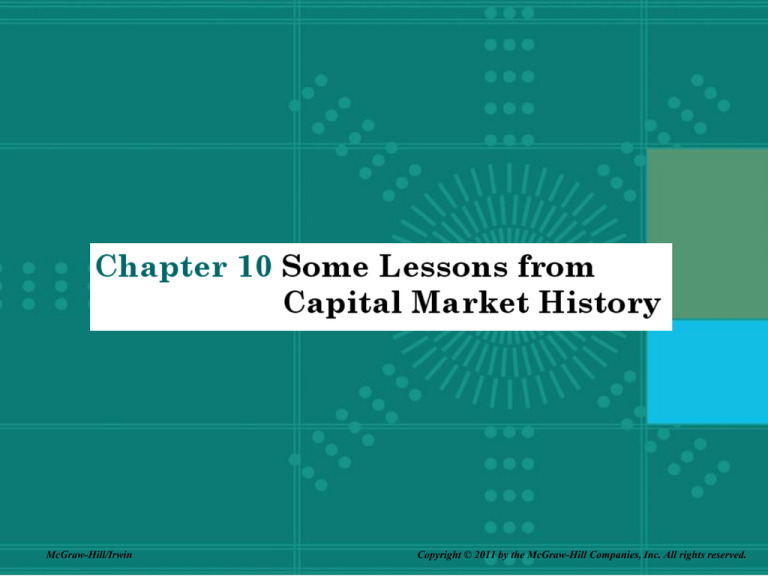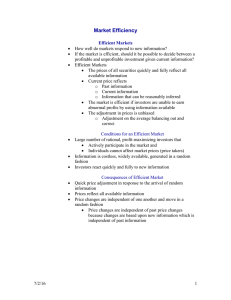
10-1
McGraw-Hill/Irwin
Copyright © 2011 by the McGraw-Hill Companies, Inc. All rights reserved.
Key Concepts and Skills
Understand:
– How to calculate the return on an
investment
– The historical returns on various types
of investments
– The historical risks on various types of
investments
– The implications of market efficiency
10-2
Chapter Outline
10.1
10.2
10.3
10.4
10.5
10.6
Returns
The Historical Record
Average Returns: The First Lesson
The Variability of Returns: The
Second Lesson
More on Average Returns
Capital Market Efficiency
10-3
Risk–Return Tradeoff
• Two key lessons from capital
market history:
– There is a reward for bearing risk
– The greater the potential reward,
the greater the risk
10-4
Dollar & Percent Returns
• Total dollar return = the return on an
investment measured in dollars
• $ Return = Dividends + Capital Gains
• Capital Gains = Price received – Price paid
• Total percent return = the return on an
investment measured as a percentage of
the original investment.
• % Return = $ Return/$ Invested
10-5
Percent Return
Dividend Yield
Capital Gains
Yield
Dt 1
DY
Pt
Pt 1 Pt
CGY
Pt
% Return DY CGY
Dt 1 Pt 1 Pt
% Return
Pt
10-6
Example: Calculating Total Dollar
and Total Percent Returns
•
•
•
•
You invest in a stock with a share price of $25.
After one year, the stock price per share is $35
Each share paid a $2 dividend
What was your total return?
Dividend
Capital Gain
Dollars
$2.00
$35 - $25 = $10
Percent
$2/25 = 8%
$10/25= 40 %
Total Return
$2 + $10 = $12
$12/$25 = 48%
10-7
U.S.
Financial
Markets
The Historical
Record: 19252008
Figure 10.4
10-8
Average Returns: The First Lesson
1926 - 2008
Investment
Large Stocks
Average Return
11.7%
Small Stocks
16.4%
Long-term Corporate Bonds
6.2%
Long-term Government Bonds
6.1%
U.S. Treasury Bills
3.8%
Inflation
3.1%
Table 10.2
10-9
Historical Average Returns
• Historical Average Return = simple, or arithmetic
average
T
Historical Average Return
yearly return
i1
T
• Using the data in Table 10.1:
– Sum the returns for large-company stocks from 1926
through 2008, you get about 9.71/83 years = 11.7%.
• Your best guess about the size of the return for a
year selected at random is 11.7%.
10-10
Risk Premiums
• Risk-free rate:
– Rate of return on a riskless investment
– Treasury Bills are considered risk-free
• Risk premium:
– Excess return on a risky asset over the
risk-free rate
– Reward for bearing risk
10-11
Historical Risk Premiums
•
•
•
•
•
Large Stocks:
11.7 – 3.8 = 7.9%
Small Stocks:
16.4 – 3.8 = 12.6%
L/T Corporate Bonds:
6.2 – 3.8 = 2.4%
L/T Government Bonds: 6.1 – 3.8 = 2.3%
U.S. Treasury Bills:
3.8 – 3.8 =
0*
* By definition!
Table 10.3
10-12
Return Variability Review
• Variance = VAR(R) or σ2
– Common measure of return dispersion
– Also call variability
• Standard deviation = SD(R) or σ
– Square root of the variance
– Sometimes called volatility
– Same "units" as the average
10-13
Return Variability:
The Statistical Tools for Historical Returns
• Return variance: (“T" =number of returns)
R
T
VAR(R) σ 2
i 1
i
R
2
T 1
• Standard Deviation:
SD(R) σ
VAR(R)
10-14
Return Variability Review and
Concepts
• Normal distribution:
– A symmetric frequency distribution
– The “bell-shaped curve”
– Completely described by the mean and
variance
• Does a normal distribution describe
asset returns?
10-15
The Normal Distribution
Figure 10.11
10-16
Arithmetic vs. Geometric Mean
• Arithmetic average:
– Return earned in an average period over multiple
periods
– Answers the question: “What was your return in an
average year over a particular period?”
• Geometric average:
– Average compound return per period over multiple
periods
– Answers the question: “What was your average
compound return per year over a particular period?”
• Geometric average < arithmetic average unless
all the returns are equal
10-17
Efficient Capital Markets
• The Efficient Market Hypothesis:
– Stock prices are in equilibrium
– Stocks are “fairly” priced
– Informational efficiency
• If true, you should not be able to earn
“abnormal” or “excess” returns
• Efficient markets DO NOT imply that
investors cannot earn a positive return in
the stock market
10-18
Reaction of stock price to new information in
efficient and inefficient markets
Figure 10.13
10-19
Forms of Market Efficiency
• Strong-form Efficient Market:
– Information = Public or private
– “Inside information” is of little use
• Semistrong-form Efficient Market:
– Information = publicly available information
– Fundamental analysis is of little use
• Weak-form Efficient Market:
– Information = past prices and volume data
– Technical analysis is of little use
10-20
Strong Form Efficiency
• Prices reflect all information, including
public and private
• If true, then investors can not earn abnormal
returns regardless of the information
they possess
• Empirical evidence indicates that markets
are NOT strong form efficient
– Insiders can earn abnormal returns (may be
illegal)
10-21
Semistrong Form Efficiency
• Prices reflect all publicly available
information including trading
information, annual reports, press
releases, etc.
• If true, then investors cannot earn abnormal
returns by trading on public information
• Implies that fundamental analysis will not
lead to abnormal returns
10-22
Weak Form Efficiency
• Prices reflect all past market information
such as price and volume
• If true, then investors cannot earn
abnormal returns by trading on market
information
• Implies that technical analysis will not lead
to abnormal returns
• Empirical evidence indicates that markets
are generally weak form efficient
10-23
Efficient Market Hypotheses
STRONG
Public & Private
Information
WEAK
SEMISTRONG
Public Information
Security Market
Information
10-24
Chapter 10
END
10-25









